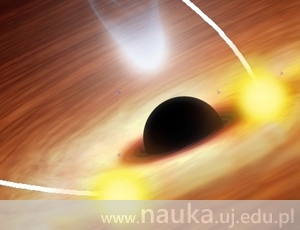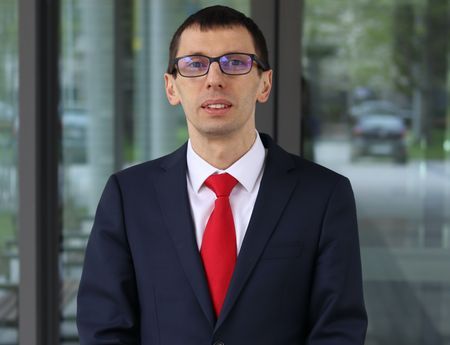
The observations conducted at the end of 2015 allowed a group of astronomers to measure the spin of one of the most massive black holes in the Universe, located in the OJ287 blazar.
Nearly 20 optical telescopes as well as NASA's Swift robotic spacecraft participated in the observations. Their target was a supermassive black hole, with mass equal to 18 billion solar masses, located at the centre of the OJ287 quasar, 3.5 billion light years away from us. The observations were coordinated by Prof. Stanisław Zoła from the JU Astronomical Observatory and were conducted for several months by nearly 100 astronomers from several countries. Their research has shown that the spin of the black hole is close to one third of the maximum value assumed by Einstein when he formulated the General Relativity Theory.
Double burst
Quasars are very bright regions at the centres of active galaxies which emit immense amounts of electromagnetic radiation due to the matter being sucked into massive black holes located in the midst of them. A large amount of particles is also thrown out in the form of relativistic jets, and if such a jet is directed towards the Earth, then that particular quasar is called a blazar.
The OJ287 quasar is located in the blue sphere near the ecliptic (the apparent path of the Sun on the celestial sphere), where astronomers have observed small Solar system objects for decades. The analysis of this historical data, which by chance was also related to OJ287, enabled the scientists to see the changes in the quasar's brightness in the span of 100 years (beginning in 1891). They observed peculiar bursts in the region happening every 12 years. Additionally, they concluded that these bursts have a double burst variability.
 This property allowed Mauri Valtonen (University of Turku, Finland) and his team to create a model of the object. It shows that the centre of OJ287 is occupied not by one, but two black holes with radically different masses. The more massive one is surrounded by an accretion disc, composed from the matter it sucked from interstellar space. The other hole, much smaller (150 million solar masses), revolves around the large one on a very tight, highly elliptical orbit every 12 years, punching through the accretion disc twice in the process. This phenomenon causes heating of matter and the observed double bursts.
This property allowed Mauri Valtonen (University of Turku, Finland) and his team to create a model of the object. It shows that the centre of OJ287 is occupied not by one, but two black holes with radically different masses. The more massive one is surrounded by an accretion disc, composed from the matter it sucked from interstellar space. The other hole, much smaller (150 million solar masses), revolves around the large one on a very tight, highly elliptical orbit every 12 years, punching through the accretion disc twice in the process. This phenomenon causes heating of matter and the observed double bursts.
Bright flare in OJ287
Based on General Relativity Theory, the model suggests that the orbit of the less massive black hole should spin and have a high precession (change of orientation of the rotating axis). The precession was already measured in 2010, and it amounts to as much as 39 degrees per one rotation. This allowed scientists to predict that the next bursts will be observed in 2015/2016, and indeed they happened in November, coinciding with the 100th anniversary of general relativity theory.
The international observation campaign started in September 2015. The flare grew brighter on 18 November, attaining its full brightness on 4 December. It was not this bright for about 30 years. Estimating the time of this burst allowed for a direct measurement of the black hole's spin, which is 0.31 of the maximum value proposed in the General Relativity Theory.
Optical observations took place in several countries: Japan, South Korea, India, Turkey, Greece, Finland, Poland, Germany, Spain, the USA, Chile and Mexico. In Poland, the observations and polarimetric analyses were conducted in the Pedagogical University of Kraków Mt. Suhora Astronomical Observatory and the JU Astronomical Observatory by their staff and PhD candidates. Amateurs with their own telescopes also participated in the observations. Images from the Swift robot spacecraft were performed and analysed by Stefano Ciprini from Italy, while the theoretical model was prepared by Mauri Valtonen and A. Gopakumar (Tata Institute of fundamental Research, India).
Photo: The model of the OJ 287 blazar's central region (Martin Mobberley).
Original text: www.nauka.uj.edu.pl





